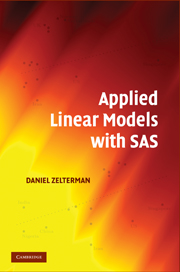Book contents
- Frontmatter
- Contents
- Preface
- Acknowledgments
- 1 Introduction
- 2 Principles of Statistics
- 3 Introduction to Linear Regression
- 4 Assessing the Regression
- 5 Multiple Linear Regression
- 6 Indicators, Interactions, and Transformations
- 7 Nonparametric Statistics
- 8 Logistic Regression
- 9 Diagnostics for Logistic Regression
- 10 Poisson Regression
- 11 Survival Analysis
- 12 Proportional Hazards Regression
- 13 Review of Methods
- Appendix: Statistical Tables
- References
- Selected Solutions and Hints
- Index
6 - Indicators, Interactions, and Transformations
Published online by Cambridge University Press: 05 June 2012
- Frontmatter
- Contents
- Preface
- Acknowledgments
- 1 Introduction
- 2 Principles of Statistics
- 3 Introduction to Linear Regression
- 4 Assessing the Regression
- 5 Multiple Linear Regression
- 6 Indicators, Interactions, and Transformations
- 7 Nonparametric Statistics
- 8 Logistic Regression
- 9 Diagnostics for Logistic Regression
- 10 Poisson Regression
- 11 Survival Analysis
- 12 Proportional Hazards Regression
- 13 Review of Methods
- Appendix: Statistical Tables
- References
- Selected Solutions and Hints
- Index
Summary
Linear regression is sometimes more than we really need. A simple rule about whether or not to take a different action is often adequate. When you look at the fuel gauge on your car, at what point do you begin to look for a gas station? An indicator variable takes a continuous measurement and cuts it up into two discrete categories.
We can also transform variables in a nonlinear fashion if this serves to reduce leverage or make the data look more like a straight line. Interactions are variables we use in a regression model to see if the explanatory value of two variables is greater than the sum of their parts. A pizza with two toppings may be much better than two separate halves with the individual toppings. Or perhaps it may be worse.
Indicator Variables
Water boils at a lower temperature at high altitude, and experienced cooks know that recipes need to be adjusted accordingly. Consider the recipe given in Table 6.1. Most important, notice the footnote about making an adjustment for high altitude. This is expressed in terms of a change that suddenly needs to be made above a critical height above sea level. Ideally, the person preparing this dish should first obtain an accurate measure of the altitude and then use a calculator to determine the precise amount of adjustment that needs to be made. Nobody would consider doing this, of course. Instead we are instructed to use this easily remembered rule that takes effect above a critical level.
- Type
- Chapter
- Information
- Applied Linear Models with SAS , pp. 120 - 149Publisher: Cambridge University PressPrint publication year: 2010



